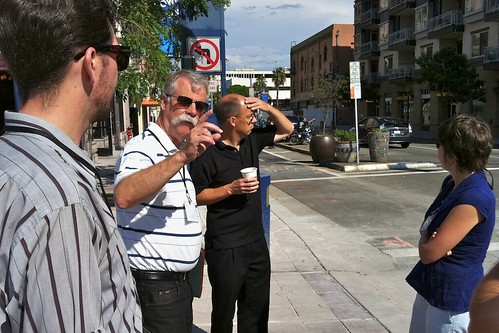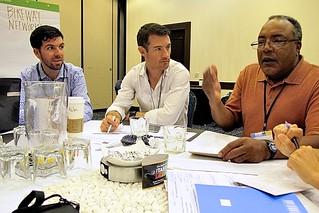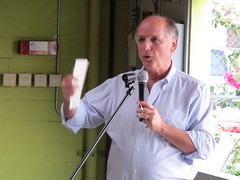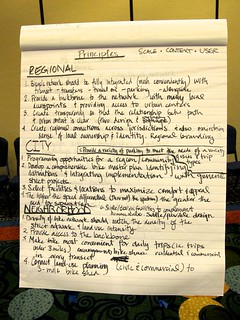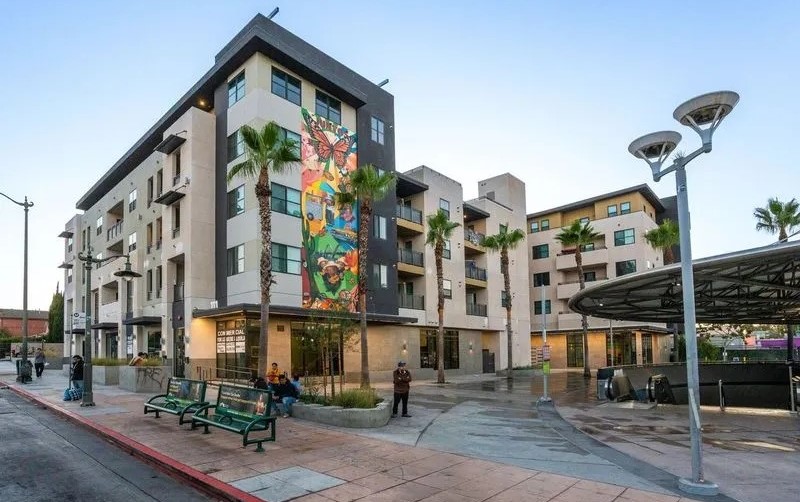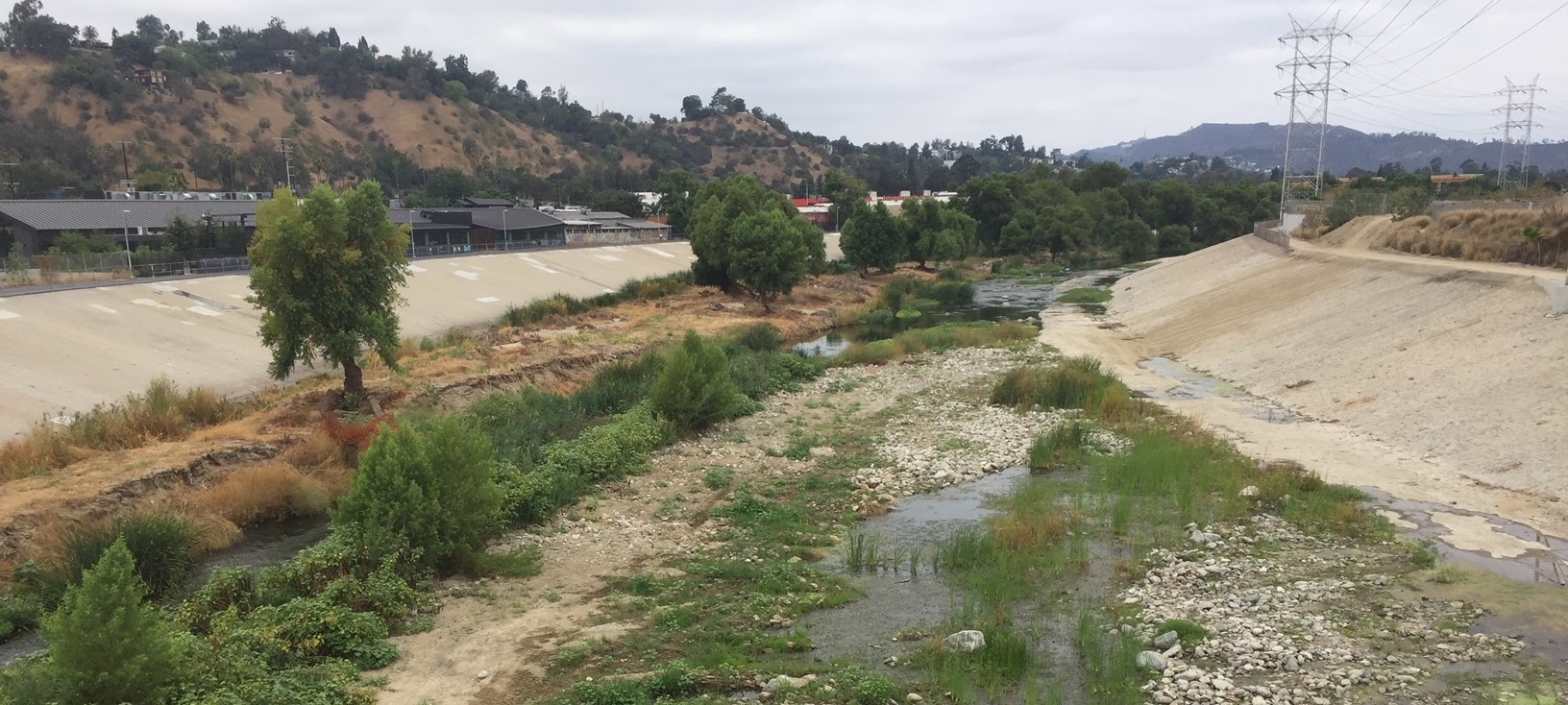Preceding the start of the Pro-Walk/Pro-Bike/Pro-Place conference this week, the Congress for the New Urbanism met at the Renaissance Hotel across from the Long Beach Convention Center to convene their annual CNU Transportation Summit. At the summit, CNU develops its transportation agenda, including new and existing projects. Having caught the new urbanist bug in Florida at CNU 20, I was eager to have another opportunity to both learn and contribute to their dialogue.
The summit is organized in a manner similar to the "open source" sessions of the full CNU conference each year. Smaller breakout groups, with a leader for each, split off to tackle various topics in a close circle of collaboration. The summit groups included: Transit Networks, Highways to Boulevards, Transportation Reform Modeling, Regional Policy & Functional Classification Reform, Transportation Reform Research Agenda, Street Vitality Index, and Bikeway Networks. Behind many of the big ideas, reports and documents distributed by the CNU and its membership over the years, there were first small groups hashing things out together on note pads.
I spent the majority of my time at the summit working with the Bikeway Networks group, led by Mike Lydon. Lydon is the founding principle of the Street Plans Collaborative, and an accomplished professional and advocate who has been involved in a wide range of projects, including as a primary instigator of tactical urbanism. Bikeways, as its own topic, was new to the transportation summit, and Lydon expressed interest in framing bicycling in the established contexts of urban to rural transects central to CNU thinking and practice.
At the mixer event on the first night of the two-day summit, Stefanos Polyzoides -- one of the founders of CNU, a resident of Pasadena, and an architect who passionately advocates walkable urban design and quality public spaces in Los Angeles -- gave an insightful talk on the unique history, assets and challenges of the Southern California metropolitan region. He said Southern California is a place that has always functioned regionally, first as connected villages, towns, cities, and finally as metropolitan and international economy. It was also a region that was once 20 percent urban and 80 percent agricultural where humans had settled, before the relentless march of sprawl in every direction.
Polyzoides also referred to the notion of spending billions of dollars for the I-710 highway tunnel as a “capital crime." A bold statement like that might have raised eyebrows in many places, but it was well received in a room full of thinkers devoted to undoing the damage done to the public realm by overbuilt urban highways. For CNU, breaking down urban freeways, replacing them with more human-scaled boulevards, and selling the adjacent land is a fiscally conservative position, as it should be.
One of the key moments of the summit was the debate between Jeffrey Tumlin of NelsonNygaard Consulting Associates, who has been closely involved in Santa Monica planning efforts including the Land Use and Circulation Element and Bike Action Plan, and John Horsley, executive director of the American Association of State Highway and Transportation Officials (AASHTO). AASHTO recently released a list of America’s “Top 10 Transportation Projects”, which was quickly skewered on Streetsblog DC by Angie Schmitt.
It was impressive that Horsley would enter a lion's den like the CNU -- and also reflective of changing times. He started by joking he hoped he wouldn’t get any pies thrown at him. Tumlin took jabs at AASHTO’s latest reforms, saying they had moved their standards "out of the 1950's and into 1970's." Horsley conceded CNU's smart move in making its agenda a fiscally conservative one, saying, “We're broke. There is an opening.” He said the new era of fiscal constraint and the need for financial sustainability will force state DOTs to adapt.
The debate remained civil, but there were occasional tense moments, such as when an audience member dismissed the notion that safety has always been a top priority of traffic engineering, given the United States' dismal track record on traffic safety compared to other developed nations. It was a point of contention for which there was really no adequate response.
There was far too much happening simultaneously during the primary working sessions to adequately cover it all. For a more detailed take on the transit discussion, Jarrett Walker, author of Human Transit, has posted his initial thoughts of the summit on his blog.
Members of each group also pledged to continue the dialogue and collaboration beyond the summit. The bikeway group set its first goal for a tangible product to be a document highlighting bike route street grids of a handful of selected model cities. This would help to identify characteristics of network coverage and quality as they relate to increased bicycle mode share and levels of urban intensity, as defined in the CNU transect model.
The two fruitful days of the conference showed how much CNU and bike specific advocates can benefit from each other. The bike advocates have a lot of energy and momentum right now in building a broad grassroots movement. The CNU offers a broader analysis of how all the pieces of a city, and its land use, fit together to become more than the sum of it parts, which more bicycle advocates need to be attuned to. However, some of the more nuanced details of bikeway implementation are not fully fleshed out in the CNU’s approach and planning documents, which have largely focused on improving the pedestrian realm, and could benefit from more bicycling perspectives.
To truly tackle the scale of the issues we face in the 21st century, and the nearly insurmountable extent of the damage automobile dependency has already done to the human habitat of North America, this movement is going to need to grow in size and clout. It's not as easy to sell a broad and loosely defined concept like New Urbanism to the public as it is a single issue like bicycling, but we're going to have to do better public relations. The widespread adoption of a comprehensive and enduring vision for the future of human settlement is an urgent need, and becoming more so with every passing year.
CNU 21 in Salt Lake City has its work cut out for it.
For attendees of the Pro Walk/Pro Bike/Pro Place conference, if you are interested, I will be speaking on a panel on Thursday during the 10:15 am breakout session titled, Communicating Value on the Cheap: Using Digital Tools to Grow Bike Ped & Placemaking Advocacy. Other speakers include Brendan Crain, the communications manager for Project for Public Spaces; Jonathan Nettler, managing editor at Planetizen; and Alissa Walker (aka Gelatobaby). I’ll be kicking off my discussion on the experience of helping organize #FlightVsBike at last year’s “Carmageddon”.
